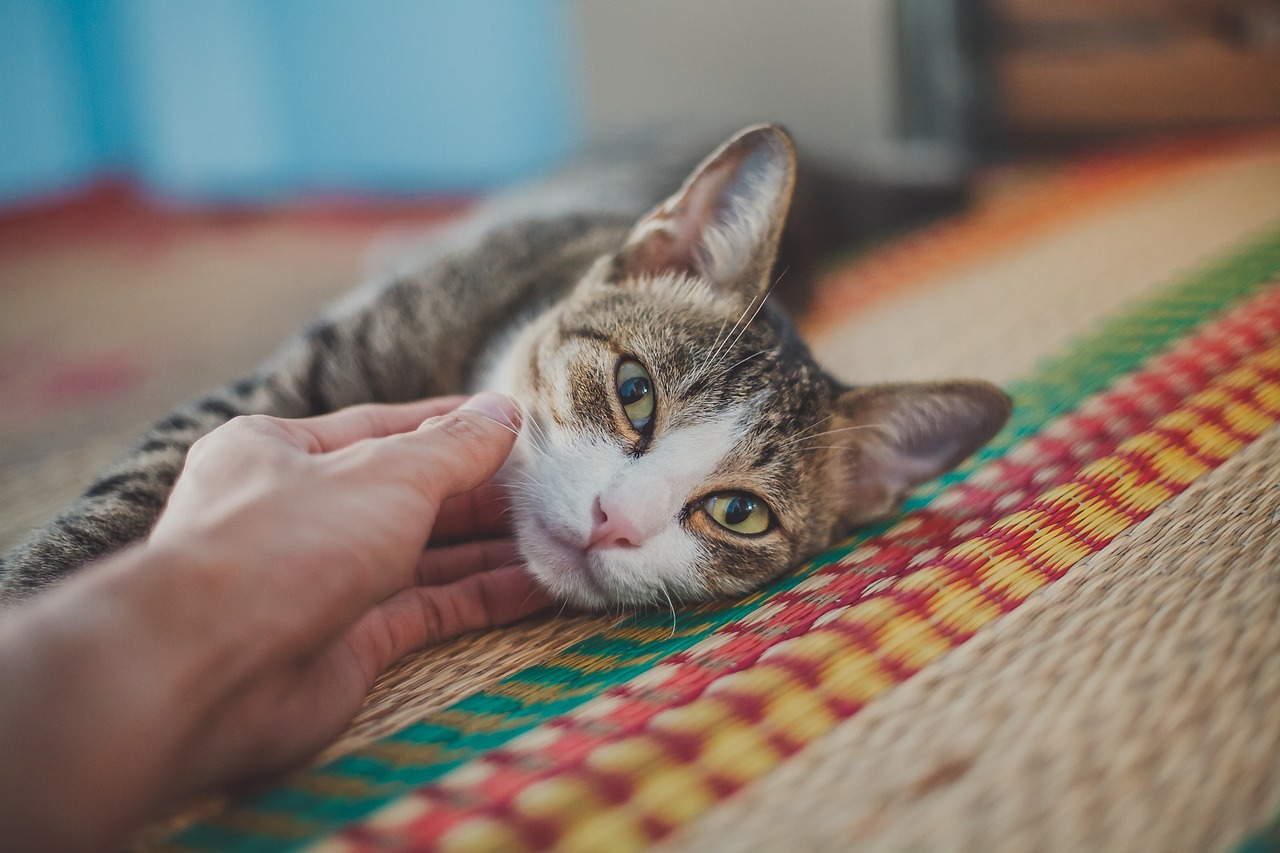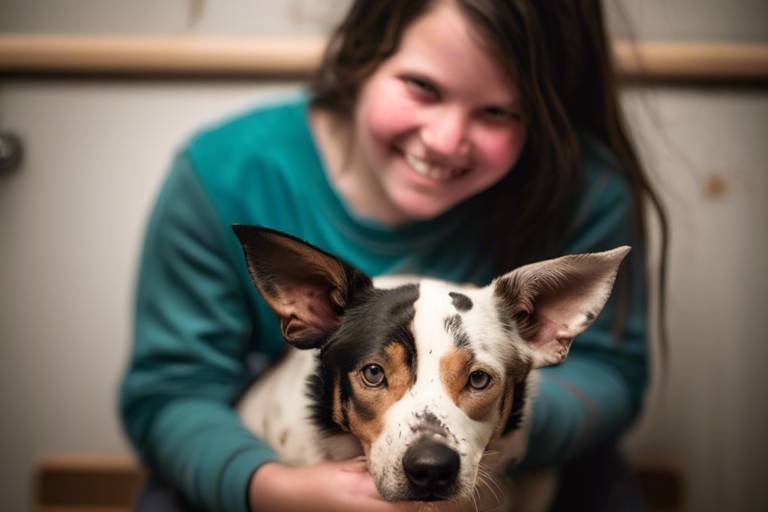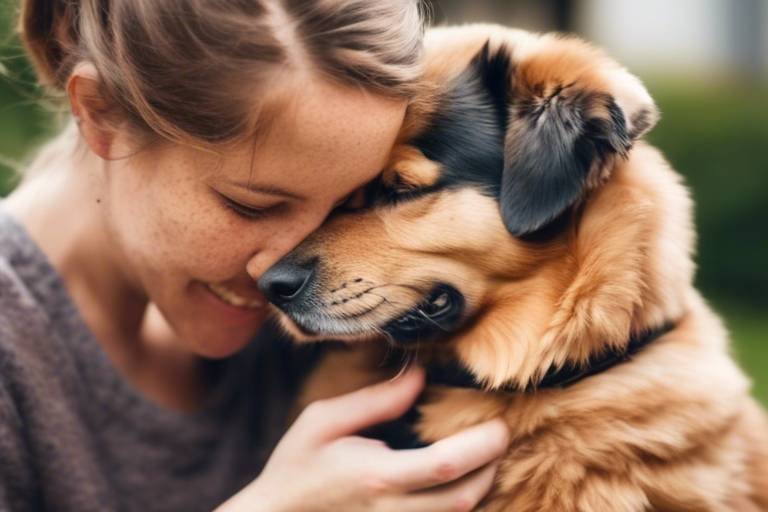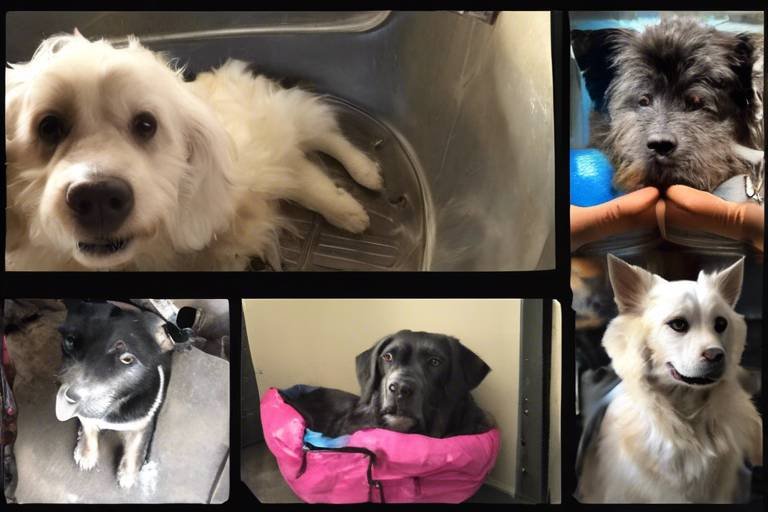Tips for Successfully Integrating a New Pet into Your Home
Welcoming a new pet into your home can be one of the most exciting and rewarding experiences of your life. Imagine the joy of having a furry friend by your side, wagging their tail or purring contentedly as you relax together. However, this transition can also be a bit overwhelming, both for you and your new companion. To ensure a smooth integration, it's essential to implement strategies that promote harmony and happiness within your household. In this article, we’ll explore various aspects of introducing a new pet into your home, from preparing your environment to fostering a strong bond. So, grab a cup of coffee, sit back, and let’s dive into the world of pet integration!
Creating a pet-friendly environment is crucial for a successful transition. Start by assessing your living space and identifying any potential hazards. For instance, secure loose wires, remove toxic plants, and ensure that small objects are out of reach. It’s also important to designate a specific area for your new pet, complete with a cozy bed, food and water bowls, and toys. This will help your pet feel safe and comfortable in their new surroundings. Remember, a little preparation goes a long way in making your home welcoming!
Selecting the appropriate pet for your lifestyle is vital. Not every pet is a perfect match for every family. Consider factors such as your activity level, living situation, and family dynamics. For example, if you have young children, a playful dog might be a great fit, while a quiet cat could be ideal for a more laid-back household. Take some time to reflect on the following key lifestyle factors:
Understanding your daily routine and commitments can help determine the best type of pet for you. Ask yourself questions like: How much time do I spend at home? Am I active or more of a couch potato? Do I have children or other pets? These questions will guide you in making an informed decision.
Every pet requires time and attention. Dogs, for instance, need regular walks and playtime, while cats may be more independent but still crave interaction. Before bringing a new pet into your home, think about how much time you can realistically dedicate to their care. It’s not just about feeding them; it’s about building a relationship!
Different pets have varying space needs. If you live in a small apartment, a smaller breed dog or a cat might be more suitable than a large dog that needs room to roam. Assess your living space and ensure it accommodates your new pet comfortably. A little extra room can make a big difference in their happiness.
Different breeds have unique characteristics. For instance, some dog breeds are known for their energy levels, while others are more laid-back. Researching breed traits can help you find a compatible match for your home. Understanding these traits will not only help you choose the right pet but also prepare you for their specific needs.
The introduction process is critical for successful integration. It’s important to take your time and allow your new pet to adjust to their environment. Rushing the introduction can lead to stress for both your pet and your family. Here are a few effective strategies for introducing your new pet to your family and existing pets:
Taking a slow approach to introductions can reduce stress. Start by allowing your new pet to explore their designated area while keeping them separate from existing pets. Gradually introduce them to family members and other pets, allowing for supervised interactions. This will help everyone feel more comfortable and reduce the chances of conflict.
Establishing safe zones for your new pet can ease anxiety. Designate quiet areas where your pet can retreat when feeling overwhelmed. This could be a cozy corner with their bed, toys, and blankets. Having a safe space allows your new pet to acclimate at their own pace.
Consistency is key to a successful integration. Establishing routines for feeding, exercise, and training can help your new pet adjust to their new life. Pets thrive on predictability, and having a set schedule can make them feel secure.
A consistent feeding schedule helps pets feel secure. Choose specific times for meals and stick to them. This not only helps in establishing a routine but also aids in training your pet to understand when it’s time to eat.
Regular exercise is essential for a pet’s well-being. Incorporate exercise into your daily routine to keep your pet healthy and happy. Whether it’s daily walks, playtime in the yard, or interactive games, finding activities that both you and your pet enjoy will strengthen your bond.
Training is crucial for a well-adjusted pet. It’s not just about obedience; it’s about creating a harmonious home. Effective training techniques and socializing your new pet with other animals and people are essential for their development.
Teaching your pet basic commands fosters good behavior. Start with simple commands like "sit," "stay," and "come." Consistent training sessions will help your pet understand what is expected of them and create a positive environment.
Socializing your pet is vital for their confidence. Expose them to different environments, people, and other animals in a safe manner. This will help them become well-rounded and adaptable companions.
Keeping an eye on your new pet’s health is essential. Regular veterinary visits and monitoring your pet's behavior for signs of stress or illness are crucial for their well-being. Being proactive about their health will ensure a long and happy life together.
Routine veterinary visits are crucial for health. Schedule regular check-ups to ensure your pet remains healthy and happy. Your vet can provide valuable advice on nutrition, vaccinations, and preventive care.
Understanding your pet's body language can help you identify stress. Common signs of stress include excessive barking, hiding, or changes in eating habits. Being attuned to these signals allows you to address issues before they escalate.
Establishing a strong bond with your new pet enhances your relationship. Spend quality time together, engage in play, and show affection. These moments will create lasting memories and help your pet feel secure in their new home.
Spending quality time is essential for bonding. Explore various activities you can enjoy together, such as going for walks, playing fetch, or simply snuggling on the couch. The more time you spend together, the stronger your connection will become.
Using positive reinforcement can improve training and behavior. Reward good behavior with treats, praise, or playtime. This not only encourages your pet to repeat those behaviors but also builds trust between you.
Adapting to life with a new pet can be challenging. It’s important to adjust your lifestyle and expectations to accommodate your new family member. Remember, patience and understanding are key during this transition.
Being patient is key during the adjustment period. Understand that your pet may need time to acclimate to their new surroundings. Give them the space they need, and don’t hesitate to reach out for support if needed.
Don’t hesitate to ask for help. There are plenty of resources available for pet owners, including training classes, community support groups, and online forums. Connecting with others can provide valuable insights and encouragement.
Q: How long does it take for a new pet to adjust?
A: Every pet is different, but generally, it can take anywhere from a few days to a few weeks for a new pet to fully adjust to their new home.
Q: What should I do if my new pet shows signs of stress?
A: If your pet shows signs of stress, provide them with a safe space, keep interactions calm, and consult your veterinarian if the stress persists.
Q: How can I help my new pet bond with my family?
A: Encourage family members to spend quality time with the pet through play, training, and affection. Consistency and positive reinforcement will help strengthen the bond.

Preparing Your Home
Welcoming a new pet into your home is an exciting journey filled with love and companionship, but it also requires careful planning. Creating a pet-friendly environment is crucial to ensure a smooth transition for both you and your new furry friend. Imagine your home as a blank canvas; it’s your job to paint it in a way that is safe and welcoming for your new family member. Start by assessing your living space and identifying potential hazards that could pose risks to your pet.
First and foremost, you should pet-proof your home. This means securing loose wires, keeping toxic plants out of reach, and ensuring that small objects that could be swallowed are stored away. Just like you would child-proof your house for a toddler, think of your new pet as a curious little explorer who will investigate every nook and cranny. Consider these essential steps:
- Remove Toxic Substances: Many household items are harmful to pets, including certain plants, cleaning products, and human foods like chocolate or grapes.
- Secure Cables and Wires: Pets, especially puppies and kittens, love to chew on things. Tuck away any exposed wires to prevent accidents.
- Designate Pet Areas: Create specific areas in your home where your pet can feel safe and relaxed. This could be a cozy corner with a bed, toys, and water.
Next, consider the layout of your home. If you have stairs, it may be wise to install gates to prevent your new pet from wandering into unsafe areas. Think of it as setting up a mini fortress for your pet, where they can explore freely without encountering dangers. Additionally, if you have existing pets, it’s important to create a space where they can retreat if they feel overwhelmed by the new arrival.
Another important aspect of preparing your home is ensuring that you have all the necessary supplies before your pet arrives. Here’s a quick checklist of essentials:
| Item | Description |
|---|---|
| Food and Water Bowls | Choose sturdy, non-tip bowls that are appropriate for your pet's size. |
| Pet Bed | A comfortable bed provides a safe space for your pet to rest. |
| Toys | Interactive toys can keep your pet entertained and mentally stimulated. |
| Leash and Collar | Essential for walks and outings, ensure they fit well and are comfortable. |
| Grooming Supplies | Brushes, nail clippers, and shampoos suitable for your pet's breed. |
Finally, remember that your new pet will need time to adjust to their new surroundings. Just as we feel nervous in unfamiliar places, your pet may take a little while to feel at home. Be patient and give them the space they need to explore at their own pace. With a little preparation, you can create a warm and inviting atmosphere that will make your new pet feel right at home from day one!

Choosing the Right Pet
When it comes to welcoming a new furry friend into your home, making the right choice is absolutely crucial. Not only will the right pet fit seamlessly into your family dynamics, but it will also enhance your lifestyle and bring you endless joy. So, how do you go about selecting the perfect companion? It's all about understanding your unique situation and what you can offer to a pet. Let's dive into some essential factors that will help you make an informed decision.
First and foremost, you need to assess your lifestyle. Think about your daily routine, your work commitments, and even your hobbies. Do you travel often? Are you home most of the day? Understanding your lifestyle will help you determine what type of pet will thrive in your environment. For instance, if you're often away from home, a low-maintenance pet like a fish or a hamster might be more suitable than a high-energy dog that requires regular exercise and companionship.
Next, consider the time commitment involved in pet ownership. Every pet requires a certain amount of attention, care, and love. Dogs, for example, need daily walks, playtime, and training, while cats may require less interaction but still need mental stimulation and engagement. Ask yourself, “How much time can I realistically dedicate to a new pet?” If you can only spare a couple of hours a day, a pet with lower energy levels or one that is more independent might be the way to go.
Another important factor to consider is space. The amount of room you have at home can significantly influence your choice of pet. Large breeds like Great Danes or energetic dogs like Border Collies need ample space to roam and play, while smaller pets, such as rabbits or guinea pigs, can thrive in smaller living environments. Take a good look at your living situation and ask yourself, “Does my home have enough space for the type of pet I want?”
Moreover, it’s essential to research breed traits. Different breeds come with their unique characteristics, temperaments, and care requirements. For instance, some dog breeds are known for being friendly and good with children, while others might be more reserved or require extensive training. Take the time to read about various breeds and their needs, and consider visiting local shelters or breeders to interact with different animals. This hands-on experience can provide invaluable insight into what might be the best fit for your household.
Ultimately, choosing the right pet is about finding a match that complements your lifestyle and enriches your life. By carefully considering your time, space, and the unique traits of different animals, you can ensure that both you and your new companion will be happy and fulfilled in your shared journey. Remember, adopting a pet is not just a one-time decision; it’s a long-term commitment that requires love, patience, and understanding.
- How do I know if I’m ready for a pet? Consider your daily schedule, financial stability, and willingness to commit time and energy to a new companion.
- What are the best pets for families with children? Breeds known for their friendly and gentle nature, like Labrador Retrievers or Beagles, are often great choices.
- Can I adopt a pet if I live in a small apartment? Yes! Smaller pets like cats, rabbits, or small dog breeds can thrive in smaller spaces.
- What should I do if I’m unsure about which pet to choose? Research different breeds, visit shelters, and consult with pet professionals to find the best fit for your lifestyle.
Assessing Your Lifestyle
Before you bring a new pet into your home, it's essential to take a step back and assess your lifestyle. This is not just about what kind of pet you want; it's about understanding how a furry friend will fit into your daily routine. Think about your work hours, social activities, and family commitments. Do you travel often? How much time can you realistically dedicate to your new companion? These questions are crucial because they will help determine the best type of pet for you and your family.
For instance, if you work long hours or travel frequently, a low-maintenance pet like a fish or a small rodent might be a better fit than an energetic dog that requires daily walks and playtime. On the other hand, if you have a flexible schedule and love being active, a dog that enjoys outdoor adventures could be your perfect match.
Moreover, consider the following factors when evaluating your lifestyle:
- Work Schedule: How many hours do you spend at work? Are you home during the day or away for long periods?
- Family Dynamics: Do you have children or other pets? How will they interact with a new addition?
- Activity Level: Are you an active person who enjoys long walks and outdoor activities, or do you prefer a more relaxed lifestyle?
- Financial Considerations: Pets can be expensive. Ensure you can afford food, veterinary care, and other necessities.
Taking the time to evaluate these aspects of your life will not only help you choose the right pet but also set the stage for a harmonious relationship between you and your new companion. Remember, adopting a pet is a long-term commitment, and understanding your lifestyle will help ensure that both you and your new furry friend thrive together.
Q: How do I know if I'm ready for a pet?
A: Assess your daily routine, financial situation, and willingness to commit time and energy to a pet. If you're prepared to make adjustments and prioritize your pet's needs, you're likely ready.
Q: What if I have children?
A: Evaluate the ages of your children and their ability to interact with pets. Some pets are more suitable for families with young kids, while others may require a more calm environment.
Q: Can I have a pet if I work full-time?
A: Yes, but consider pets that require less attention or look into options like doggy daycare or hiring a pet sitter for socialization and exercise.
Q: How do I choose the right type of pet?
A: Research different breeds and their traits, assess your lifestyle, and consider your living space. It’s important to find a pet that complements your daily life.
Time Commitment
When you decide to welcome a new pet into your home, one of the most critical factors to consider is the involved. Pets are not just cute companions; they require dedication and attention to thrive. Just like a new family member, your pet will need your time for various activities, including feeding, training, exercise, and social interaction.
Think about your daily routine. Are you often away from home for long hours due to work or other commitments? If so, you might want to reconsider the type of pet you choose. For example, dogs typically require more time and interaction than cats, who are often more independent. Here’s a quick breakdown of how different pets might fit into your schedule:
| Pet Type | Time Required Daily | Activities |
|---|---|---|
| Dog | 2-3 hours | Walks, playtime, training, grooming |
| Cat | 30 minutes - 1 hour | Playtime, feeding, grooming |
| Fish | 15-30 minutes | Feeding, tank maintenance |
| Small mammals (hamsters, guinea pigs) | 1 hour | Feeding, cage cleaning, playtime |
As you can see, the time commitment varies significantly depending on the type of pet you choose. It’s essential to be realistic about how much time you can dedicate each day. If you’re frequently busy, you might consider a pet that requires less interaction, or even adopting two pets that can keep each other company when you’re not home. This way, they can play and socialize together, easing the burden on you.
Moreover, establishing a routine is vital for both you and your pet. Pets thrive on consistency, so setting aside specific times for feeding, walks, and playtime can help create a structured environment. This not only benefits your pet but also helps you manage your time better. Here are some tips to help you with your time management:
- Plan Ahead: Schedule your pet care tasks just like any other important appointment.
- Involve Family Members: Share the responsibilities among family members to lighten the load.
- Use Technology: Consider pet care apps that can remind you of feeding or exercise times.
Remember, the more time you invest in your pet, the stronger your bond will become. A well-cared-for pet is not only happier but also healthier, leading to a more fulfilling relationship for both of you. So, take a moment to reflect on your lifestyle and how a new pet will fit into it. The time you commit now will pay off in the long run with a loving and well-adjusted companion.
Q1: How much time should I dedicate to training my new pet?
A1: It's recommended to spend at least 15-30 minutes a day on training, especially during the first few weeks. This helps establish good behavior and strengthens your bond.
Q2: Can I leave my pet alone during the day?
A2: Yes, but the amount of time depends on the pet type. Dogs shouldn't be left alone for more than 4-6 hours, while cats can manage longer periods alone.
Q3: What if I have a busy schedule?
A3: If you're busy, consider pets that require less attention, like cats or small mammals. You can also hire a pet sitter or ask friends to help out.
Q4: How can I ensure my pet gets enough exercise?
A4: Schedule regular walks or play sessions and consider interactive toys that can keep your pet engaged. Joining a pet group can also provide socialization and exercise opportunities.
Space Considerations
When it comes to welcoming a new pet into your home, one of the most critical factors to consider is the space you have available. Just like humans, pets come in various shapes and sizes, and their needs can vary significantly based on their breed, age, and energy levels. It’s essential to create an environment that allows your new furry friend to thrive. Imagine trying to fit a Great Dane into a tiny apartment; it just wouldn’t work, right? So, let’s dive into some key aspects of space considerations that will help you make the best choice for your new companion.
First and foremost, think about the size of your living space. If you live in a cozy studio apartment, a smaller breed or a calm cat might be the perfect fit. On the other hand, if you have a spacious house with a yard, you might consider larger breeds or even multiple pets. Pets need room to roam, play, and relax, so evaluating your home layout is a must. Here are some points to ponder:
- Indoor Space: Ensure that you have enough room for your pet to move around freely. Consider the layout of your furniture and how it might affect your pet’s mobility.
- Outdoor Space: If you have a backyard, is it securely fenced? Do you have enough space for your pet to run and play? Outdoor space can greatly enhance your pet’s quality of life.
- Accessibility: Are there stairs or other obstacles that might be challenging for your new pet, especially if they are older or have mobility issues?
Next, consider the energy level of the pet you’re thinking about adopting. High-energy dogs, like Border Collies or Retrievers, require ample space to run and play. They thrive in environments where they can burn off their energy. Conversely, lower-energy breeds may be perfectly content lounging around in a smaller area. Assessing your potential pet’s energy level in relation to your living space will help you make a more informed decision.
Additionally, think about the number of pets you currently have or plan to adopt. If you already have pets, it’s crucial to ensure that your living space can comfortably accommodate everyone. Introducing a new pet into an already established household requires careful thought about how each animal will coexist. It’s not just about physical space; it’s also about ensuring that each pet has its own area where it can feel safe and secure. This might include:
- Separate sleeping areas
- Distinct feeding zones
- Individual play spaces
Finally, don’t forget to consider the future. Pets can live for many years, and your living situation may change during that time. If you anticipate moving or if your family dynamics might shift, think about how these changes could impact your ability to care for your pet. Being proactive about space considerations can save you and your new companion a lot of stress down the line. Remember, the goal is to create a harmonious living environment where both you and your pet can thrive together.
Q: How much space does my new pet need?
A: It depends on the breed and size of your pet. Generally, larger breeds require more space to move around, while smaller pets can adapt to smaller living areas. Always consider their energy levels and activity needs.
Q: Can I have multiple pets in a small space?
A: Yes, but it requires careful planning. Ensure that there is enough space for each pet to have its own area for sleeping, eating, and playing to minimize stress and potential conflicts.
Q: What if my living situation changes?
A: It's important to think ahead. If you plan to move or anticipate changes in your family, consider how these changes will impact your pet's living environment. Being adaptable will help ensure a smooth transition for your pet.
Researching Breed Traits
When it comes to welcoming a new pet into your home, is a crucial step that can greatly influence your experience. Just like people, pets have unique personalities, temperaments, and needs that vary by breed. Imagine inviting a guest into your home without knowing their likes and dislikes; it could lead to awkward situations, right? The same principle applies to pets. Understanding the characteristics of different breeds can help you find the perfect match for your family and lifestyle.
For instance, some breeds are known for their high energy levels and require ample exercise, while others may be more laid-back and content with a cozy spot on the couch. Before making a decision, consider factors such as size, activity level, grooming needs, and temperament. For example, if you live in a small apartment, a large, energetic dog might not be the best fit. On the other hand, a smaller breed or a cat could thrive in that environment.
Additionally, it's important to think about your family's dynamics. Do you have young children? Some breeds are more tolerant and patient with kids, while others may not be as forgiving. Researching breed traits can provide insights into how a particular breed typically interacts with children and other animals. Here’s a quick overview of some common breed traits:
| Breed | Size | Energy Level | Grooming Needs | Temperament |
|---|---|---|---|---|
| Labrador Retriever | Large | High | Moderate | Friendly, Outgoing |
| Bulldog | Medium | Low | Low | Docile, Willful |
| Poodle | Varies | Moderate to High | High | Intelligent, Active |
| Beagle | Medium | High | Low | Curious, Friendly |
Conducting thorough research can also involve reading books, visiting reputable websites, and even talking to breeders or shelters. They can provide valuable insights into the breed's history, common health issues, and specific care requirements. By investing time in this research, you are not just selecting a pet; you are choosing a new family member who will share your life for many years to come.
Remember, every pet is an individual, and while breed traits can guide you, each animal has its own unique personality. So, keep an open mind, and be prepared for some surprises along the way. After all, the journey of pet ownership is filled with joy, laughter, and, yes, a few challenges. But with the right breed match, you can create a harmonious and fulfilling relationship that enriches both your life and your new pet's.
- What should I consider when choosing a pet breed? Look at factors like size, energy level, grooming needs, and temperament to find a breed that fits your lifestyle.
- How can I learn more about a specific breed? Research through books, reputable websites, and discussions with breeders or shelters can provide valuable insights.
- Are all pets of the same breed the same? No, each pet has its own personality, so while breed traits can guide you, individual differences are important to consider.

Introducing Your New Pet
Welcoming a new pet into your home is an exciting adventure, but it’s also a delicate process that requires careful planning and execution. The way you introduce your new furry friend to your family and existing pets can significantly impact their comfort and integration. Think of it like throwing a party; you wouldn’t just invite someone in without a proper introduction, right? It’s all about making everyone feel at ease and ensuring that the new addition feels welcomed and secure.
First and foremost, it's essential to create a calm environment during the introduction phase. This means minimizing loud noises and distractions, which can be overwhelming for your new pet. You might want to consider setting up a quiet area where your new pet can feel safe. This could be a cozy corner of a room or even a separate room where they can acclimate to their new surroundings without feeling bombarded. Imagine how you would feel if you were suddenly dropped into a bustling crowd; it’s only natural to want a little space to breathe.
When it comes to introducing your new pet to family members, it’s best to take a gradual approach. Start with short interactions, allowing your pet to get accustomed to each person’s scent and presence. You might want to use treats or toys to create positive associations. For instance, have family members offer treats while calmly speaking to the pet. This not only helps the pet associate family members with positive experiences but also creates a sense of safety and trust. Remember, patience is key. Just like building a friendship, it takes time to foster a bond.
If you have existing pets, the introduction process requires even more care. Animals, much like humans, can be territorial and may not immediately accept a newcomer. To facilitate a smoother introduction, consider the following steps:
- Allow your existing pets to sniff the new pet's belongings before they meet. This can help them familiarize themselves with the new scent.
- Use a barrier, such as a baby gate or a crate, to let them see and smell each other without direct contact at first.
- Monitor their interactions closely, and be ready to intervene if any signs of aggression or stress arise.
Creating a safe space for your new pet is also crucial. Designate a specific area where they can retreat if they feel overwhelmed. This could be a cozy bed in a quiet corner or a crate that they can call their own. Just like we all need a little “me-time” sometimes, pets also benefit from having their own space to relax and recharge.
In summary, introducing your new pet is a pivotal step in ensuring a harmonious household. By taking your time, creating a calm environment, and facilitating gradual introductions, you’re setting the stage for a beautiful relationship between your new pet and your family. Remember, the goal is to create a welcoming atmosphere that fosters trust and security for everyone involved.
To further assist you in the process of introducing your new pet, here are some common questions pet owners often have:
- How long does it take for pets to adjust to a new family member? Every pet is different, but typically, it can take anywhere from a few days to a few weeks for a pet to adjust.
- What should I do if my pets don’t get along? If tensions rise, separate the pets and try reintroducing them after a few days. Consult a veterinarian or a professional trainer if necessary.
- Can I introduce my new pet to my existing pets right away? It’s best to wait a few days to allow your new pet to acclimate before introducing them to existing pets.
Gradual Introductions
Introducing a new pet to your home can feel like a delicate dance, and it’s essential to approach it with care and thoughtfulness. Just like people, pets can experience anxiety and stress when faced with new environments or companions. To ensure a smooth transition, are key. This method involves slowly acclimating your new pet to their new surroundings and the existing family members—both human and furry. Think of it as a gentle unfolding of a story, where each chapter builds upon the last, creating a narrative of trust and comfort.
Start by allowing your new pet to explore their designated space while keeping them separate from other pets. This gives them a chance to familiarize themselves with their new environment without feeling overwhelmed. You might want to set up a cozy corner with their bed, toys, and food. Once they seem comfortable, you can begin the introduction process. Here are some tips to help you along the way:
- Controlled Meetings: Use a leash or crate during initial introductions to maintain control. This helps prevent any sudden aggressive reactions and allows your new pet to feel secure.
- Short Interactions: Keep the first meetings brief. A few minutes is often enough to start; you can gradually increase the time as they become more comfortable with each other.
- Positive Reinforcement: Reward both pets with treats and praise for calm behavior during introductions. This helps them associate each other with positive experiences.
As the days progress, gradually increase the duration of their interactions. Monitor their body language closely—look for signs of stress, such as growling, excessive barking, or hiding. If you notice any of these behaviors, don’t hesitate to separate them and try again later. Remember, patience is your best friend in this process. Just like a fine wine, relationships take time to mature!
It’s also important to allow your existing pets to express their feelings about the new addition. They may feel a bit displaced or jealous, and it's crucial to reassure them that they are still loved and valued. Spend quality time with them to help alleviate any insecurities. You might consider engaging them in their favorite activities or providing them with special treats during this transition period.
Ultimately, the goal of gradual introductions is to foster a peaceful coexistence. By taking the time to let each pet adjust at their own pace, you’re setting the stage for a harmonious household. In the end, remember that every pet is unique, and what works for one may not work for another. Be flexible and attentive to their needs, and you’ll create a loving and welcoming home for all.
Q: How long should I wait before introducing my new pet to my existing pets?
A: It’s best to wait at least a few days to a week before introducing your new pet. This allows them to acclimate to their new environment first.
Q: What if my pets don’t get along right away?
A: It’s normal for pets to take time to adjust to one another. Keep their interactions short and supervised, and try to remain patient. If tensions persist, consider consulting a professional trainer.
Q: Should I use treats during the introduction process?
A: Yes! Treats can help create positive associations. Make sure to reward both pets for calm behavior during introductions.
Creating Safe Spaces
When you bring a new pet into your home, one of the most important things you can do is to create safe spaces for them. Imagine how overwhelming it must be for your furry friend to transition from a familiar environment to a new one, filled with strange smells, sounds, and people. By providing them with a sanctuary where they can feel secure, you can help ease their anxiety and make the adjustment period smoother. Safe spaces can be a cozy corner in your living room, a quiet room away from the hustle and bustle, or even a designated crate that your pet can call their own.
To effectively create a safe space, consider the following key elements:
- Location: Choose a quiet area in your home where your pet can retreat when they need some alone time. This could be a corner of your bedroom, a separate room, or even a cozy nook in the living room.
- Comfort: Make the space inviting by adding a soft bed or blanket, some toys, and perhaps a piece of your clothing to provide comfort through familiar scents.
- Accessibility: Ensure that the area is easily accessible for your pet. If they are shy or nervous, they should be able to reach their safe space without feeling pressured.
Additionally, it’s vital to keep this space free from disturbances. Family members and other pets should understand that this area is off-limits when your new pet is inside, allowing them to relax without interruption. You can even use a baby gate to create a physical barrier if needed. This way, your new companion can retreat to their safe space whenever they feel overwhelmed, which is especially important during the initial introduction phase.
As your pet becomes more comfortable in their new environment, you might notice them spending less time in their safe space. This is a good sign that they are adjusting well! However, it’s essential to always keep that space available for them, as they may need it from time to time, especially in new or stressful situations.
Creating safe spaces is more than just a physical area; it’s about providing emotional security. By understanding your pet's needs and ensuring they have a sanctuary to retreat to, you help them feel loved and protected. This, in turn, fosters a deeper bond between you and your new furry friend, paving the way for a harmonious relationship.
Q1: How long should my pet stay in their safe space?
A1: It depends on the individual pet. Some may feel comfortable exploring after a few days, while others might prefer to retreat to their safe space for weeks. Always let your pet dictate their comfort level.
Q2: Can I use a crate as a safe space?
A2: Absolutely! A crate can be an excellent safe space if your pet is crate-trained and feels comfortable inside. Just ensure it is a positive environment, filled with their favorite toys and bedding.
Q3: What if my other pets invade the safe space?
A3: It’s crucial to establish boundaries. Use baby gates or designate the area clearly to prevent other pets from intruding. Training your other pets to respect these boundaries can also help.

Establishing Routines
When it comes to integrating a new pet into your home, consistency is key. Establishing routines not only helps your new companion feel secure, but it also fosters a sense of normalcy in their new environment. Just like humans thrive on schedules, pets do too! Imagine how chaotic life would be without a daily routine; the same goes for your furry friend. By setting up a predictable schedule for feeding, exercise, and training, you create a harmonious atmosphere that promotes trust and stability.
First and foremost, let's talk about feeding schedules. A consistent feeding routine can make a world of difference for your pet. It helps them understand when to expect food, which reduces anxiety and food-related behavioral issues. For example, if you feed your pet at the same times each day, they will learn to anticipate mealtime, which can be a comforting routine for them. You can use a simple table to outline a feeding schedule:
| Time | Meal |
|---|---|
| 8:00 AM | Breakfast |
| 12:00 PM | Lunch |
| 6:00 PM | Dinner |
Next up is exercise. Just like humans need to stay active to maintain good health, pets require regular exercise to stay fit and happy. Establishing a routine for walks, playtime, or even training sessions can help channel your pet's energy positively. For instance, if you take your dog for a walk every morning at 7 AM, they will come to expect that time as their outdoor adventure. And let’s be honest, a tired pet is a happy pet!
Additionally, training is another essential routine that should not be overlooked. Training sessions not only teach your pet essential commands but also strengthen the bond between you and your new companion. Aim for short, engaging sessions that fit into your daily routine. For example, you might incorporate training after your pet's morning walk, making it a part of their daily activities. Remember, patience is crucial. It may take time for your pet to learn new commands, but with consistent practice, they'll get there!
In summary, establishing routines for feeding, exercise, and training can significantly ease the transition for your new pet. By providing a structured environment, you help your pet feel safe and loved, paving the way for a lasting bond. So, grab that leash, fill those bowls, and get ready to enjoy the delightful journey of pet ownership!
- How long does it take for a pet to adjust to a new routine? Every pet is different, but generally, it can take anywhere from a few days to a few weeks for them to fully adjust.
- What if my pet resists the routine? It's important to be patient. Gradually introduce the routine and use positive reinforcement to encourage your pet to adapt.
- Can I change the routine later on? Yes, routines can be adjusted as needed. Just be sure to introduce changes gradually to avoid stressing your pet.
Feeding Schedules
Establishing a consistent feeding schedule is one of the most important aspects of integrating a new pet into your home. Just like humans thrive on routine, pets feel more secure and settled when they know what to expect. Imagine how comforting it is to know that dinner is served at the same time every day; pets feel the same way! A well-structured feeding routine not only helps your furry friend adjust but also fosters good behavior and health.
When setting up a feeding schedule, consider your pet's age, size, and activity level. For instance, puppies and kittens require more frequent meals compared to adult pets. Typically, you might feed a puppy three to four times a day, while adult dogs usually do well with two meals. Cats, on the other hand, thrive on smaller, more frequent meals throughout the day. Here’s a simple table to illustrate a basic feeding schedule for different types of pets:
| Pet Type | Age | Feeding Frequency |
|---|---|---|
| Dog | Puppy | 3-4 times a day |
| Dog | Adult | 2 times a day |
| Cat | Kittens | 3-4 times a day |
| Cat | Adult | 2-3 times a day |
Once you've established how often to feed your pet, the next step is to determine the right amount of food. This can vary based on the pet's size, breed, and even the specific food you choose. Always refer to the feeding guidelines on the pet food package, but remember that these are just starting points. You may need to adjust based on your pet's individual needs. If your pet seems to be gaining or losing weight, consult your veterinarian for tailored advice.
Another key point to consider is the timing of meals. Feeding your pet at the same times each day helps regulate their digestive system and can even aid in house training for dogs. To make life easier, you might want to set reminders on your phone or use a feeding chart to keep track of meal times.
Lastly, always ensure that your pet has access to fresh water throughout the day. Hydration is just as important as nutrition, and having clean water available encourages healthy drinking habits. Remember, a happy pet is a well-fed and well-hydrated pet!
- How much food should I feed my pet? Always refer to the feeding guidelines on the pet food package, and adjust based on your pet's individual needs.
- Can I change my pet's feeding schedule? Yes, but do it gradually to avoid upsetting their stomach.
- Is it okay to give my pet treats? Treats are fine in moderation, but they should not make up more than 10% of your pet's daily caloric intake.
Exercise Needs
When it comes to welcoming a new pet into your home, understanding their is paramount. Just like humans, pets thrive on physical activity, and it plays a crucial role in their overall well-being. Think of exercise as the fuel that keeps your furry friend energized and happy. A well-exercised pet is less likely to engage in destructive behaviors and more likely to bond with you and your family.
Different pets have different exercise requirements. For example, a high-energy dog breed, like a Border Collie, will need significantly more exercise compared to a laid-back cat. It's essential to tailor the exercise regimen to your new pet's specific breed and personality. Generally, dogs require at least 30 minutes to 2 hours of exercise daily, while cats might enjoy shorter bursts of playtime throughout the day.
Here are some effective ways to incorporate exercise into your daily routine:
- Daily Walks: Taking your dog for a walk not only provides them with exercise but also offers an opportunity for socialization and exploration. Aim for at least one walk a day, adjusting the duration based on your dog's energy level.
- Playtime: Engage in interactive play with your pet, whether it's throwing a ball, using a laser pointer for cats, or tugging on a rope toy. This not only fulfills their exercise needs but also strengthens your bond.
- Training Sessions: Incorporating training into your routine can be a fun way to exercise your pet's mind and body. Teaching new tricks or commands keeps them mentally stimulated and physically active.
Moreover, creating a structured exercise schedule can help both you and your pet stay on track. Consider factors such as your pet's age, breed, and health status when planning their exercise routine. For instance, puppies and young dogs often have boundless energy and may require more frequent exercise sessions, while older pets might benefit from gentler, shorter walks.
In addition to physical activity, mental stimulation is equally important. Puzzle toys, treat-dispensing balls, and interactive games can keep your pet's mind engaged and help reduce boredom. Just like us, pets can get bored, and that can lead to mischief!
Lastly, always pay attention to your pet's body language during exercise. Signs of fatigue, excessive panting, or reluctance to engage can indicate that they need a break. It's crucial to adapt their exercise routine based on their needs and health conditions. By doing so, you'll not only ensure your pet stays fit but also create a joyful and fulfilling environment for them in your home.
Q: How much exercise does my dog need?
A: Generally, dogs need at least 30 minutes to 2 hours of exercise daily, depending on their breed and energy level.
Q: Can my cat get enough exercise indoors?
A: Yes! Indoor cats can benefit from interactive play sessions, climbing structures, and puzzle toys to keep them active.
Q: What are signs that my pet is getting too much exercise?
A: Signs include excessive panting, lethargy, reluctance to continue, or any signs of discomfort. Always be attentive to your pet's needs.
Q: How can I make exercise fun for my pet?
A: Incorporate games, use toys, and vary the routine to keep exercise exciting. Dogs enjoy fetch, while cats may love chasing laser pointers or feather toys.

Training and Socialization
Training your new pet is not just important; it’s essential for creating a harmonious living environment. Think of training as the foundation of your relationship with your furry friend. Just like teaching a child to read, training a pet helps them understand the world around them and how to navigate it safely. Without proper training, your pet may struggle with behaviors that can lead to frustration for both you and them. So, let’s dive into some effective training techniques that can set your new companion up for success!
First off, basic commands are crucial. Teaching your pet simple commands such as "sit," "stay," and "come" can be the cornerstone of good behavior. Not only do these commands help in managing your pet's actions, but they also enhance communication between you and your furry friend. For instance, if you’re at the park and your dog spots a squirrel, a quick "come" can keep them safe. Here’s a quick table summarizing the essential commands you might want to teach:
| Command | Purpose |
|---|---|
| Sit | Helps in controlling your pet's movements. |
| Stay | Prevents your pet from wandering off. |
| Come | Ensures your pet returns to you when called. |
| Leave it | Teaches your pet to ignore distractions. |
Moreover, socialization is equally important. Just like humans, pets thrive on interaction. Exposing your new pet to a variety of environments, people, and other animals can significantly boost their confidence and reduce anxiety. Think of socialization as a way to broaden their horizons. For example, visiting a dog park or attending pet-friendly events can provide your furry friend with the opportunity to meet other pets and people, which is invaluable for their growth.
But how do you ensure that your pet has positive socialization experiences? Gradual introductions are key. Start by introducing your pet to new experiences one at a time, rather than overwhelming them with too much at once. For instance, if you’re introducing your dog to another dog, do it in a neutral space where both pets feel safe. This can help avoid territorial disputes and foster a positive interaction.
Additionally, consider enrolling your pet in training classes or socialization groups. Not only do these classes provide professional guidance, but they also offer a structured environment for your pet to learn and interact with others. Plus, it’s a fantastic way for you to meet other pet owners and share experiences!
In conclusion, training and socialization are vital components of welcoming a new pet into your home. By investing time in teaching basic commands and providing ample socialization opportunities, you’re not just creating a well-behaved pet; you’re also nurturing a lifelong bond that will enrich both your lives. Remember, patience and consistency are your best friends in this journey!
- How long does it take to train a new pet? Training duration varies by pet and command, but consistency is key. Generally, expect a few weeks for basic commands.
- What if my pet doesn't respond to training? Every pet learns at their own pace. If you're struggling, consider consulting a professional trainer for guidance.
- How can I socialize my pet safely? Start with controlled environments, gradually introducing them to new experiences while monitoring their comfort level.
Basic Commands
When you bring a new pet into your home, teaching them basic commands is not just a fun activity; it's a crucial step in fostering a harmonious living environment. Imagine your furry friend sitting quietly when you ask them to, or coming to you when you call their name. Sounds delightful, right? These simple commands can significantly enhance your relationship and ensure safety for both your pet and your family. Not only do they help in managing your pet's behavior, but they also provide mental stimulation, which is essential for their overall well-being.
To get started, here are some fundamental commands that every pet should learn:
- Sit: This is often the first command to teach. It’s simple and helps your pet learn to be calm and patient.
- Stay: This command is essential for keeping your pet in one place, especially in potentially dangerous situations.
- Come: Teaching your pet to come when called is vital for their safety. It’s also a great way to reinforce your bond.
- Leave it: This command can prevent your pet from picking up harmful objects or engaging in undesirable behaviors.
- Down: This command encourages your pet to lie down, promoting relaxation and good behavior.
Each command requires patience and consistency. Start with short training sessions, ideally lasting no more than 5 to 10 minutes, to keep your pet engaged and eager to learn. Use positive reinforcement techniques, such as treats or praise, to reward your pet when they successfully follow a command. This approach not only encourages them to repeat the behavior but also builds trust between you and your new companion.
As your pet masters these basic commands, you can gradually introduce more complex tricks. This progression keeps the learning process exciting and challenges your pet mentally. Remember, the goal is to make training a fun and rewarding experience for both of you. So, grab some treats, get ready to have some fun, and watch as your pet flourishes with each new command!
Q1: How long does it take for a pet to learn basic commands?
A1: The time it takes for a pet to learn commands varies by individual. Some pets may grasp commands within a few days, while others might take weeks. Consistency and patience are key!
Q2: Can I train an older pet to learn commands?
A2: Absolutely! Older pets can learn new commands, but they may require more patience and time than younger pets. The principle of positive reinforcement still applies.
Q3: What if my pet doesn’t respond to training?
A3: If your pet seems unresponsive, try to identify distractions or stressors in the environment. Sometimes, a quieter setting can help. Additionally, consider consulting a professional trainer for guidance.
Q4: Is it necessary to train my pet in commands?
A4: Yes! Training your pet in basic commands enhances safety, improves behavior, and strengthens your bond. It’s a fundamental aspect of responsible pet ownership.
Socialization Opportunities
Socializing your new pet is a vital step in ensuring they grow up to be a well-adjusted and confident companion. Just like humans, pets thrive on interaction and learning from their environment. Think of socialization as a way to introduce your furry friend to the world around them, helping them understand how to behave in various situations. It's not just about meeting other animals; it's about building their confidence and helping them feel secure in their surroundings.
One of the best ways to provide socialization opportunities is through puppy or kitten classes. These classes are designed to expose young pets to different people, sounds, and environments in a controlled setting. Not only do they learn essential skills, but they also have the chance to interact with other pets their age. This experience can be incredibly beneficial in shaping their behavior and reducing fear in new situations.
Additionally, consider arranging playdates with other friendly pets. If you have friends or family members with well-behaved animals, invite them over for a casual meet-and-greet. This not only helps your pet learn how to interact with others but also gives you the opportunity to observe their behavior in a social setting. You'll be amazed at how quickly they adapt and learn from their peers!
Don't forget about community events! Many neighborhoods host pet-friendly gatherings, such as dog parks or local pet fairs. These events are fantastic for exposing your pet to new sights, sounds, and smells. Just be sure to keep a close eye on your pet, especially if they're a bit shy or anxious. You want these experiences to be positive, not overwhelming.
Lastly, consider enrolling your pet in obedience training classes. Not only do these classes teach essential commands, but they also provide a structured environment for socialization. Your pet will learn to focus on you, even amidst distractions, which is a crucial skill for their overall well-being. Plus, it's an excellent way for you to connect with other pet owners and share experiences.
In summary, socialization is key to developing a happy and well-adjusted pet. By providing a variety of opportunities for interaction, you can help your new companion navigate the world with confidence. Remember, the more positive experiences they have, the better prepared they'll be to handle new situations throughout their lives.
- How early should I start socializing my pet? It's best to start socializing your pet as early as possible, ideally during their critical socialization period, which is typically between 3 and 14 weeks of age.
- What if my pet is shy or fearful? Take it slow! Gradually introduce them to new experiences and environments. Always prioritize positive reinforcement to build their confidence.
- Can older pets be socialized? Yes! While it might take more time and patience, older pets can still benefit from socialization. Just be mindful of their comfort levels and proceed at their pace.

Monitoring Health and Well-being
When it comes to welcoming a new pet into your home, one of the most crucial aspects is monitoring their health and well-being. Just like humans, pets require regular check-ups and a keen eye on their behavior to ensure they are thriving in their new environment. After all, a happy pet makes for a happy home!
First things first, let's talk about routine veterinary visits. These check-ups are essential for keeping your furry friend in tip-top shape. Regular vet visits can help catch any potential health issues early on and keep vaccinations up to date. So, mark your calendars! A good rule of thumb is to schedule a vet appointment at least once a year for adult pets and more frequently for puppies and kittens. This way, you can ensure your pet is receiving the care they need. Remember, prevention is always better than cure!
Additionally, it’s vital to monitor your pet's behavior. Pets can’t speak, so they rely on us to interpret their needs and feelings. Pay close attention to any changes in their behavior, such as eating habits, energy levels, or social interactions. For instance, if your usually playful pup suddenly becomes lethargic or disinterested in their favorite toys, it might be a sign that something is off. Here are some common signs of stress or illness to watch out for:
- Changes in appetite or weight
- Excessive barking or meowing
- Hiding or seeking solitude
- Changes in bathroom habits
Understanding your pet's body language is equally important. Just like us, pets communicate their feelings through their posture, tail position, and even their ears. For example, a wagging tail usually indicates happiness, while a tucked tail can signify fear or anxiety. If you notice any unusual body language, it’s worth investigating further to ensure your pet is feeling safe and secure.
In addition to physical health, don’t forget about your pet's mental well-being. Just like humans, pets can experience stress and anxiety, especially during transitions. To help your new companion feel at ease, provide them with plenty of enrichment activities. This could include interactive toys, puzzle feeders, or even simple games like fetch or hide-and-seek. Keeping their minds engaged can prevent boredom and destructive behaviors, making for a happier, healthier pet.
Lastly, never hesitate to reach out for help if you're unsure about your pet's health. Whether it's a quick question to your vet or seeking advice from fellow pet owners, there are plenty of resources available. Remember, being proactive about your pet's health not only enhances their quality of life but also strengthens the bond you share.
Here are some common questions pet owners have about monitoring their pet's health and well-being:
- How often should I take my pet to the vet?
It's recommended to visit the vet at least once a year for adult pets and more often for younger pets or those with existing health conditions. - What signs should I look for to know if my pet is stressed?
Common signs include changes in eating habits, excessive barking, hiding, and changes in bathroom habits. - How can I keep my pet mentally stimulated?
Provide interactive toys, engage in playtime, and offer puzzle feeders to keep their minds active.
Regular Vet Check-ups
When you bring a new pet into your home, one of the most important responsibilities you take on is ensuring their health and well-being. Regular veterinary check-ups are crucial for monitoring your pet's health, catching potential issues early, and maintaining their overall happiness. Just like you visit the doctor for an annual check-up, your furry friend needs the same kind of care. These visits help to establish a baseline of health, allowing the vet to notice any changes that might occur over time.
During a typical vet visit, your pet will undergo a thorough examination. The veterinarian will check their weight, listen to their heart and lungs, examine their eyes, ears, and teeth, and assess their overall physical condition. This comprehensive assessment is vital because some health issues can be subtle and may not show obvious symptoms until they become serious. For instance, conditions like dental disease or early signs of arthritis can go unnoticed without a professional evaluation.
Moreover, these visits are an excellent opportunity for vaccination updates and preventive care. Vaccinations protect your pet from various diseases, some of which can be life-threatening. Your vet will recommend a vaccination schedule tailored to your pet's age, breed, and lifestyle. Additionally, regular check-ups allow for discussions about parasite prevention, nutrition, and any behavioral concerns you might have.
To help you understand the importance of regular vet visits, consider the following table that outlines the typical schedule for vaccinations and check-ups:
| Age of Pet | Recommended Actions |
|---|---|
| 8 Weeks | Initial vaccinations and deworming |
| 12 Weeks | Follow-up vaccinations |
| 6 Months | Spaying/neutering and health check |
| 1 Year | Annual check-up and vaccinations |
| Every Year After | Annual health check-ups and vaccinations |
It's also essential to recognize that the frequency of vet visits may vary based on your pet's age, health status, and specific needs. For example, senior pets or those with chronic health issues may require more frequent visits to monitor their conditions closely. Always consult your veterinarian to establish a personalized schedule that best suits your pet.
In addition to physical health checks, regular vet visits offer a chance for you to ask questions and gain valuable insights into your pet's behavior and care. Perhaps you've noticed your pet acting differently or have concerns about their diet. Your vet can provide guidance and resources to help you address these issues effectively. Remember, a proactive approach to your pet's health not only enhances their quality of life but also strengthens the bond between you and your furry friend.
- How often should I take my pet to the vet? - Generally, pets should see a vet at least once a year; however, puppies and kittens may require more frequent visits.
- What should I expect during a vet visit? - Expect a thorough examination, vaccinations, and discussions about your pet's diet and behavior.
- Are vet visits expensive? - Costs can vary, but investing in regular check-ups can save money in the long run by preventing serious health issues.
Recognizing Stress Signals
As a new pet owner, one of the most crucial skills you'll need to develop is the ability to recognize stress signals in your furry friend. Just like humans, pets experience stress, and they often communicate their discomfort through various behaviors. Understanding these signs is essential for ensuring your pet's well-being and happiness. Imagine your pet as a little furry sponge, soaking up their environment; if that environment becomes overwhelming, they might express their discomfort in ways that you need to learn to interpret.
Common stress signals can manifest in several forms, and it’s important to be observant. For instance, if your pet begins to withdraw from social interactions, this could indicate they are feeling anxious or overwhelmed. They might seek out a quiet corner of the house, away from the bustle of family life. Additionally, you might notice changes in their body language. A dog that suddenly tucks its tail between its legs or a cat that flattens its ears against its head is signaling discomfort. These are not just random behaviors; they are your pet's way of saying, "I need a break!"
Other stress signals can include:
- Excessive barking or meowing: This can indicate frustration or anxiety.
- Destructive behaviors: Chewing furniture or scratching at doors may be a cry for help.
- Changes in appetite: A stressed pet may eat less or, conversely, overeat as a coping mechanism.
- Hiding or seeking isolation: If your pet is retreating to their safe space more often, they may be feeling overwhelmed.
It’s essential to monitor these signals closely, especially during the initial adjustment period after bringing your new pet home. A sudden change in behavior can often be traced back to stressors in their environment, such as loud noises, unfamiliar faces, or even changes in routine. By recognizing these stress signals early, you can take proactive steps to alleviate your pet's anxiety. For example, providing a quiet, designated space where they can retreat can help them feel more secure.
Moreover, being aware of your pet's stress signals allows you to foster a stronger bond with them. When they see that you understand their needs and can respond appropriately, it builds trust and enhances your relationship. Remember, your pet relies on you to navigate the complexities of their new environment, and being attuned to their emotional state is a vital part of that responsibility.
Q: How can I tell if my pet is stressed?
A: Look for signs such as excessive barking or meowing, changes in appetite, destructive behaviors, and withdrawal from social interactions. Pay attention to their body language as well; a tucked tail or flattened ears can indicate stress.
Q: What should I do if I recognize stress signals in my pet?
A: Create a safe space for your pet to retreat to when they feel overwhelmed, maintain a consistent routine, and consider consulting a veterinarian or a professional trainer for additional strategies.
Q: Can stress affect my pet's health?
A: Yes, prolonged stress can lead to health issues in pets, including behavioral problems, digestive issues, and a weakened immune system. It's crucial to address stress promptly.

Building a Bond
Establishing a strong bond with your new pet is not just about feeding them and providing shelter; it’s about creating a lasting relationship filled with trust and love. Think of it like planting a seed in a garden. You need to water it, give it sunlight, and nurture it to see it flourish. In the same way, spending quality time with your pet is essential for fostering a deep connection. This bond will not only enhance your relationship but also make your pet feel secure and loved in their new environment.
One of the most effective ways to build a bond is through shared activities. Whether it’s playing fetch in the yard, going for long walks, or simply snuggling on the couch, these moments create positive experiences that strengthen your connection. For example, engaging in interactive play can stimulate your pet mentally and physically, making them more receptive to your presence. Consider incorporating activities like:
- Daily walks to explore the neighborhood together
- Training sessions that focus on fun tricks or commands
- Playtime with toys that encourage interaction
Additionally, using positive reinforcement can significantly improve your training and behavior management efforts. This technique involves rewarding your pet for good behavior, which not only encourages them to repeat those actions but also builds trust between you. When your pet associates you with positive experiences, they are more likely to seek your companionship and respond to your commands. For instance, if your dog sits on command and you reward them with a treat or affection, they’ll learn that good behavior brings rewards.
Moreover, understanding your pet’s unique personality is crucial in building a bond. Each pet has its own quirks and preferences, much like humans. Spend time observing how they react to different situations, what toys they prefer, and how they like to be petted. This knowledge will help you tailor your interactions to make them feel more comfortable and cherished. For example, some pets may enjoy a good belly rub, while others might prefer gentle scratches behind the ears. The more you learn about their likes and dislikes, the more you can create a nurturing environment.
Lastly, remember that patience is key. Just like any relationship, building a bond takes time. Don’t rush the process; allow your pet to acclimate to their new home and to you at their own pace. Celebrate small victories, whether it’s your cat finally coming to you for affection or your dog learning a new trick. Each step forward is a building block in your relationship.
| Question | Answer |
|---|---|
| How long does it take to bond with a new pet? | Bonding with a new pet can take anywhere from a few days to several weeks, depending on the animal's temperament and past experiences. |
| What activities are best for bonding? | Engaging in interactive play, going for walks, and training sessions are excellent activities to strengthen your bond. |
| How can I tell if my pet trusts me? | Signs of trust include your pet seeking your attention, following you around, and displaying relaxed body language when near you. |
Quality Time Together
Spending quality time with your new pet is not just about enjoying their company; it’s about building a lasting bond that enhances your relationship. Imagine your pet as a new friend—just like any friendship, it requires time, attention, and shared experiences to flourish. So, how do you create those special moments together? Here are some engaging activities that can help you connect with your furry companion:
First and foremost, consider playtime. Engaging in interactive play is a fantastic way to bond with your pet. Whether it’s tossing a ball for your dog or using a feather toy to entice your cat, these moments of play not only provide physical exercise but also stimulate your pet's mind. It’s a win-win! Remember, every wag of the tail or purr of contentment is a sign that your pet is enjoying the time spent together.
Another wonderful way to strengthen your bond is through training sessions. Teaching your pet new tricks or commands can be incredibly rewarding for both of you. Not only does it help with discipline, but it also fosters communication and understanding. Use positive reinforcement, like treats or praise, to encourage your pet. This creates a fun and engaging environment where your pet feels safe and loved. Plus, who doesn’t love showing off a well-trained pet?
Don’t forget the importance of cuddling and relaxation. Sometimes, the best moments are those quiet times spent snuggled up together on the couch. This not only provides comfort but also reassures your pet that they are safe and cherished. Create a cozy spot in your home where you can both unwind. A soft blanket and some gentle petting can work wonders in building trust and affection.
Lastly, consider incorporating outdoor adventures into your routine. Whether it’s a leisurely stroll in the park or a hike in the woods, these outings allow your pet to explore new environments while enjoying your company. Take the time to let them sniff around and discover their surroundings—these experiences can be thrilling for them and can deepen your bond through shared adventures.
In summary, the key to fostering a strong relationship with your pet lies in the time you invest in shared experiences. Remember, it’s not just about the quantity of time spent together, but the quality of those moments that truly counts. So, get out there, have fun, and create memories that will last a lifetime!
- How much time should I spend with my new pet daily? Aim for at least 30 minutes to an hour of quality interaction each day, including playtime, training, and cuddling.
- Can I bond with my pet through activities other than play? Absolutely! Activities like grooming, training, and simply relaxing together also strengthen your bond.
- What if my pet seems disinterested in spending time with me? Be patient. Some pets take longer to adjust. Continue to offer gentle interactions and give them space when needed.
Positive Reinforcement
is one of the most effective training techniques you can use to build a strong, trusting relationship with your new pet. Imagine this: instead of scolding your furry friend for misbehavior, you reward them for good behavior. It’s like cheering for your favorite team; it encourages them to keep playing their best game! When your pet does something right, whether it’s sitting on command, using the bathroom outside, or simply being calm in a new environment, shower them with praise, treats, or their favorite toy. This not only boosts their confidence but also makes them eager to repeat the behavior.
To maximize the effectiveness of positive reinforcement, consistency is key. Make sure everyone in your household is on the same page. If one person rewards the pet for sitting while another scolds them for jumping, it can create confusion and anxiety. Establish a clear set of behaviors that will earn rewards, and be sure to communicate these rules to everyone involved in your pet's life.
Consider creating a simple reward chart to track your pet's progress. This can be a fun way to visualize their achievements and keep everyone motivated. Here’s a quick example of what that might look like:
| Date | Behavior | Reward |
|---|---|---|
| 01/01/2023 | Sit on command | Small treat |
| 01/02/2023 | Walk nicely on leash | Playtime |
| 01/03/2023 | Come when called | Favorite toy |
Additionally, it’s important to remember that the rewards should be appropriate for your pet's size and dietary needs. A tiny dog doesn’t need a large treat, and a cat might prefer a small piece of their favorite wet food over a biscuit. Tailor the rewards to what your pet enjoys the most. This personalized approach not only keeps them engaged but also strengthens your bond.
Another critical aspect of positive reinforcement is timing. The reward should come immediately after the desired behavior. If you wait too long, your pet may not associate the treat or praise with what they just did. Think of it as a high-five right after a great play; it reinforces their success in that moment.
Finally, always keep it fun! Training sessions should be enjoyable for both you and your pet. Incorporate games, play, and plenty of affection into your sessions. This not only helps your pet learn but also makes the experience a joyful one. Remember, a happy pet is a well-behaved pet!
- What is positive reinforcement? Positive reinforcement is a training method that rewards desired behaviors to encourage their repetition.
- How do I know what rewards to use? Observe your pet’s preferences; some may respond better to treats, while others may prefer toys or praise.
- Can I use positive reinforcement for older pets? Absolutely! Positive reinforcement works for pets of all ages and can help improve behavior at any stage of life.
- How long should training sessions be? Keep sessions short and fun, around 5-10 minutes, to maintain your pet’s interest and focus.
- What if my pet doesn’t respond to rewards? Try different types of rewards, adjust your timing, or ensure you're being consistent with your commands and expectations.

Adapting to Changes
Bringing a new pet into your home is like opening the door to a world of joy, but it also means stepping into a realm of adjustments. Just like when you welcome a new family member, adapting to life with a furry companion requires some effort and understanding. The first thing to remember is that patience is key. Your new pet is likely to be overwhelmed by their new surroundings, and it's important to give them the time they need to feel comfortable. Think of it as a dance; both you and your pet need to learn the steps together.
During this adjustment period, communication is vital. While you may not speak the same language, your pet communicates through body language and behavior. Take note of their signals and be responsive to their needs. For instance, if your pet retreats to a corner or seems anxious, it’s a sign they may need some alone time or a quieter environment. Creating a safe space for them can significantly ease their anxiety. This could be a cozy bed in a quiet corner or a designated area where they can feel secure.
Moreover, it's essential to adapt your daily routine to accommodate your new family member. This might mean adjusting your schedule to include regular feeding times, walks, and play sessions. Just like you would with a child, establishing a routine helps your pet feel secure and know what to expect. Here are a few tips to consider:
- Set specific feeding times and stick to them.
- Incorporate daily exercise into your routine.
- Schedule time for training and socialization.
In addition to adjusting your routine, it's also important to manage your expectations. Remember, every pet is unique, and they will have their own pace of adaptation. Some pets may take longer to settle in, while others might feel at home right away. It’s crucial to remain flexible and understanding as your new pet navigates their new life. Just like a plant needs time to grow and flourish, your relationship with your pet will blossom with care and attention.
Lastly, don't hesitate to seek support. Whether it's from fellow pet owners, training classes, or online forums, connecting with others who understand the challenges of pet ownership can be incredibly helpful. Sharing experiences and advice can provide you with new insights and make the adaptation process smoother for both you and your pet. Remember, you're not alone in this journey; there’s a whole community out there ready to lend a paw!
As you embark on this exciting journey with your new pet, you might have some questions. Here are a few frequently asked questions to help guide you:
| Question | Answer |
|---|---|
| How long does it take for a new pet to adjust? | It can take anywhere from a few days to several weeks for a pet to fully adjust to a new home, depending on their personality and history. |
| What should I do if my pet seems anxious? | Provide a safe space, maintain a consistent routine, and consult a vet or a pet behaviorist if needed. |
| How can I help my pet socialize? | Introduce them gradually to new people and environments, and consider enrolling them in socialization classes. |
Patience and Understanding
Bringing a new pet into your home is a thrilling adventure, but it also comes with its fair share of challenges. One of the most important things to remember during this transition is the value of . Just like humans, pets need time to adjust to their new surroundings, and they may not always respond the way we hope. Imagine moving to a new city; it takes time to learn the layout, make new friends, and feel comfortable in your new environment. Your pet is experiencing something similar, and your support can make all the difference.
When you first welcome your new furry friend, expect some initial hiccups. They might be shy, anxious, or even a bit mischievous as they explore their new home. It’s essential to give them the space they need to acclimate. For instance, if your dog seems hesitant to enter a room, don’t force them. Instead, allow them to take their time and approach at their own pace. This gentle approach fosters trust and helps them feel secure.
It's also crucial to understand that every pet has a unique personality and background. A rescue dog may have had a tough past, making them more fearful or reactive than a puppy that has grown up in a loving home. By being patient and observing their behavior, you can better respond to their needs. For example, if your cat hides under the couch for the first few days, don’t worry. This is a natural response to stress. Instead, create a cozy space with their favorite blanket and some toys to encourage them to come out when they’re ready.
Additionally, consider the following points to foster patience and understanding:
- Take it slow: Allow your new pet to explore their environment at their own pace.
- Watch for signs: Pay attention to your pet's body language. Signs of stress can include hiding, excessive barking, or destructive behavior.
- Use calming techniques: Consider using soothing music or pheromone diffusers to help your pet relax.
- Celebrate small victories: Acknowledge every little step your pet takes towards feeling comfortable, whether it's exploring a new room or approaching you for a pet.
Remember, the goal is to create a loving and supportive environment where your pet feels safe and secure. With time, patience, and understanding, you will build a strong bond that will last a lifetime. Your new pet will eventually come to trust you, and you’ll be rewarded with the unconditional love and companionship that only a pet can provide. So, take a deep breath, embrace the journey, and enjoy the moments of connection as you both adjust to this new chapter in your lives.
Here are some common questions pet owners have when integrating a new pet into their home:
- How long does it take for a new pet to adjust? Every pet is different, but it can take anywhere from a few days to several weeks for them to feel comfortable in their new home.
- What should I do if my pet is showing signs of stress? Give them space, create a safe retreat, and consult with a veterinarian if needed.
- Can I help my pet adjust faster? Yes! Consistent routines, patience, and gentle encouragement can help your pet acclimate more quickly.
- Is it normal for my pet to be shy or hide? Absolutely! Many pets feel overwhelmed in new environments. Allow them time to come out when they feel ready.
Seeking Support
Welcoming a new pet into your home can be a delightful yet challenging experience. It’s completely normal to feel a bit overwhelmed, especially if this is your first time. One of the best ways to navigate this journey is by . Don’t hesitate to reach out to friends, family, or even professionals who can offer guidance and encouragement. After all, it takes a village to raise a pet, just as it does to raise a child!
There are numerous resources available to pet owners that can make the transition smoother. For instance, local pet stores often offer training classes that not only teach you about basic commands but also provide a space for socialization. Community support groups can also be invaluable. They allow you to connect with other pet owners who are going through similar experiences. You might even find a buddy to share tips on training or advice on dealing with behavioral issues.
Additionally, consider online forums and social media groups dedicated to pet ownership. These platforms can be treasure troves of information where you can ask questions, share your experiences, and receive support from a community of fellow pet lovers. Remember, you're not alone in this journey! Here are some resources you might find helpful:
- Local animal shelters and rescue organizations often offer training programs.
- Veterinary clinics frequently host workshops on pet care and behavior.
- Online platforms like Reddit have communities focused on pet ownership.
- Social media groups on Facebook can connect you with local pet owners.
Lastly, don’t underestimate the value of professional help. If you encounter persistent behavioral issues or if your new pet seems particularly anxious, consulting a pet trainer or animal behaviorist can provide tailored strategies to help. These professionals can offer insights that you might not have considered and can work closely with you to ensure that both you and your pet thrive in your new life together.
Q: How can I find a good trainer for my new pet?
A: Look for trainers with positive reviews, certifications, and experience with your pet's breed. Many trainers also offer introductory sessions, so you can see if their style matches your needs.
Q: What should I do if my pet is not getting along with my other pets?
A: Gradual introductions are key. Keep the new pet in a separate space initially and allow them to sniff each other under a door. If problems persist, seek advice from a professional animal behaviorist.
Q: Are there online resources for pet training?
A: Absolutely! Websites like YouTube have countless tutorials, and platforms like the ASPCA offer free resources on training and behavior.
Frequently Asked Questions
- What should I do to prepare my home for a new pet?
Preparing your home is crucial for a smooth transition. Start by removing any hazardous items, securing loose wires, and ensuring that toxic plants or substances are out of reach. Create a designated area for your new pet with a bed, toys, and food and water bowls. This will help them feel safe and welcome in their new environment.
- How do I choose the right pet for my family?
Choosing the right pet involves assessing your family’s lifestyle, including your daily routine, activity level, and space available. Consider factors such as the time you can dedicate to a pet, the size of your living space, and any allergies family members may have. Research different breeds to find one that matches your family's dynamics and energy levels.
- What is the best way to introduce a new pet to my existing pets?
Gradual introductions are key to a successful integration. Start by allowing your new pet to explore their space while keeping them separated from existing pets. Use scent swapping and supervised meetings to help them get accustomed to each other. Always monitor their interactions closely to ensure everyone feels safe and comfortable.
- How can I establish a routine for my new pet?
Establishing a routine is essential for your pet's adjustment. Set consistent feeding times, exercise schedules, and training sessions. This predictability helps your pet feel secure and understand what to expect throughout the day. Incorporate playtime and quiet time to balance their needs for activity and rest.
- What basic commands should I teach my new pet?
Teaching basic commands such as "sit," "stay," "come," and "leave it" is vital for a well-behaved pet. These commands not only promote good behavior but also enhance safety. Use positive reinforcement techniques, like treats and praise, to encourage your pet when they successfully follow commands.
- How often should I take my pet to the vet?
Regular veterinary check-ups are important for maintaining your pet’s health. Generally, you should schedule annual visits for vaccinations and health assessments. However, if you notice any changes in behavior, appetite, or energy levels, it's crucial to consult your vet sooner to address any potential issues.
- What are some signs that my pet is stressed?
Common signs of stress in pets include excessive barking, hiding, changes in appetite, and destructive behavior. Pay attention to your pet's body language; if they seem anxious or withdrawn, it's essential to provide a safe space and consider consulting a veterinarian or a pet behaviorist for guidance.
- How can I build a strong bond with my new pet?
Building a bond with your pet involves spending quality time together through play, training, and cuddling. Engage in activities your pet enjoys, and use positive reinforcement to reward good behavior. The more time you invest in your relationship, the stronger your bond will become, leading to a happier and more trusting partnership.
- What should I do if I'm struggling to adapt to life with a new pet?
Adapting to life with a new pet can be challenging, so be patient with yourself and your pet. Seek support from friends, family, or pet communities. Consider enrolling in training classes or consulting with a professional trainer to help you navigate any difficulties. Remember, it's okay to ask for help!



















